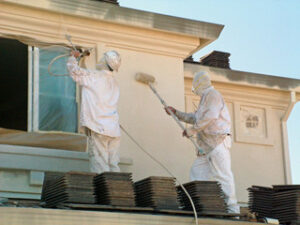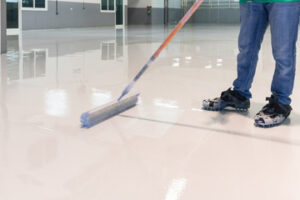Roofing Services Kalispell Montana can provide peace of mind that your new roof is installed correctly and that any issues will be repaired. They also offer warranties to protect your investment.

A roofer can be a general contractor who specializes in roofing, a licensed roofing contractor, or someone working on a crew for a company that installs roofs. Updating your home’s roof adds value and communicates its style and personality.
Pros
Roofing services are a great way to protect your home from severe damage. Not only will they repair your roof and make it look brand new, but they can also help prevent leaks and other problems by identifying weakened areas of the structure. In addition, a well-maintained roof can add value to your house and increase its curb appeal. Lastly, roofing contractors can help you choose and install proper insulation, which will keep your house cool in the summer and warm in the winter. This can help you save on your energy bills and reduce your environmental impact.
Moreover, roofing contractors are able to handle all aspects of the re-roofing process, including hiring, scheduling, and overseeing subcontractors. This makes them a great choice for large-scale projects.
Cons
A good roofing service will be able to assess the project and determine many details, such as manpower needed, equipment, and materials. They can also help shepherd the project through the inspection and permitting phases, if necessary. Roofing services will typically provide warranties for their work, which is an added bonus.
While it may be tempting to save money by going with a cheaper roofing service, the truth is that quality roofing requires precision down to the inch. A nail installed just a few inches from a valley could cause a leak, and even small mistakes can result in serious damage to your home.
Roofing contractors can advise you on the best type of insulation for your climate and home, which will help keep it cooler in the summer and warmer in the winter. This can extend the life of your roof and make it more resistant to weather damage. In addition, a well-maintained roof can add value to your home and improve its curb appeal. This is important if you plan to sell it in the future or want to attract tenants.
Cost
Roofing services are not cheap, but they are important to protect your home from water damage and other issues. In fact, a roof that is in good condition will increase the value of your home. Additionally, a well-maintained roof is more visually appealing and can improve your curb appeal.
The cost of a roofing service depends on the scope of the work and the type of material used. Minor repairs will cost less than replacing an entire roof. Roofing contractors also charge for the removal and disposal of old materials, which can add up quickly. These costs are often included in the overall estimate for the project.
Another factor that can affect the cost of a roof repair or replacement is the location of the property. Different climates and weather patterns can cause problems that require specialized expertise. For this reason, it is important to choose a local contractor who has experience in your specific area.
A professional roofing company can help you determine whether it is better to repair or replace your roof, and they will also recommend the best type of material for your house. They can also install insulation, which will save you money in the long run by keeping your house cooler in the summer and warmer in the winter.
A roofer can also inspect and evaluate your home’s structure to ensure it is safe and secure. They can check for leaks, rotted wood, and pest infestations. They can also perform structural repairs to prevent further damage to your home.
The cost of a roof replacement is higher than that of a repair, but it is more affordable than buying a new home. A professional can help you determine which type of roof is best for your needs, and they will give you an estimate for the total project cost. The estimate includes labor, supplies, and installation. It also includes any underlying or underlayment material needed for the specific roofing system. Other costs may include local material and equipment delivery costs, service provider transportation costs to the site, labor planning and setup time, cleanup time and as appropriate, time needed to achieve minimum job hours agreed upon before work begins.
Warranty
A roofing warranty is a valuable protection for homeowners. It provides assurance that the contractor will stand behind their work and will address any issues that may arise. The warranty can cover both workmanship and material, or it can be a combination of the two. The warranty also includes specific terms and conditions, which will help to manage expectations and serve the interests of all parties involved.
The type of roofing service you choose will determine what kinds of warranties you have access to. Most roofers offer a warranty, but not all will have the same quality or length of coverage. It is important to find a company that offers both a labor and materials warranty, so you are covered in case of any problems. You should also consider obtaining an extended warranty, which can add to your peace of mind.
Manufacturer warranties usually cover any defects in the roofing materials, and they can last from a few years to several decades. However, they will only cover the materials if you are using a certified roofing contractor to install them. Therefore, it is important to do your research before choosing a contractor and roofing materials.
Another important aspect of a roofing warranty is whether it covers all aspects of the installation process or only parts of it. If you are unsure, ask your roofing contractor to clarify the details of the warranty before signing a contract. Also, remember that most warranties are not transferable and will be void if you use a different contractor for maintenance or repairs.
Most roofing warranties also exclude any damage caused by storms, snowfall, lightning or other natural occurrences. It is also important to keep in mind that most warranties have exclusions, so you should carefully read the fine print and ask your roofing contractor about these.
You should also keep in mind that your roofing system is not completely waterproof, so the warranty will not protect against leaks in areas other than your roof. For this reason, it is important to inspect your roof regularly and have any damaged areas repaired promptly. This will ensure that your roof stays strong and secure against rain, wind and hail.








